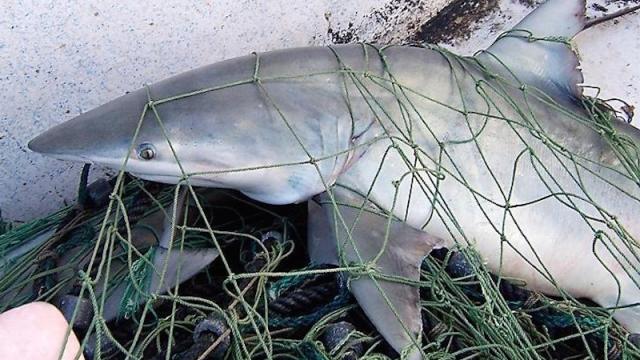Anyone who has ever gone fishing knows that you don’t always catch what you’re trying to catch. In industrial fishing, that problem is called “bycatch,” and it can have grave consequences.
It’s hard not to catch other animals swimming near the target species. Large commercial vessels fish for tuna and swordfish with miles-long lines containing tens of thousands of baited hooks. But this efficient practice has an unintended side-effect. It could completely wipe out certain species of endangered sharks.
Almost a quarter of all known species of sharks and their relatives are listed as threatened with extinction by the IUCN Red List, and bycatch is one of the greatest threats they face. “Tackling the problems associated with bycatch is essential to comprehensive, effective shark and ray conservation,” said Sonja Fordham, President of Shark Advocates International.
How to Reduce Bycatch
Countless tons of animals caught as bycatch are already dead by the time fishers realise what they have caught. Often, the fishers decide to throw the animals back, which is the worst possible solution. For animals that are injured, it’s fatal; for those that are dead, it’s incredibly wasteful. This has led to a great deal of research into new technologies and fishing strategies.
A classic example of a fishing strategy designed to reduce bycatch is so-called “dolphin-safe tuna.” Pacific tuna fishing fleets used to deploy their miles-long purse seine nets around pods of dolphins, exploiting the fact that tuna and dolphins are often found in the same place (and that dolphins are easier to spot from the surface). Before this practice was restricted, it resulted in the deaths of more than 100,000 dolphins each year.
Fishing vessels that supply dolphin-safe tuna still use the same enormous purse-seine nets, but now these nets are deployed around fish aggregation devices instead of around dolphins. This alternative fishing strategy resulted in greatly reduced dolphin bycatch, but unfortunately also resulted in greatly increased bycatch of many other species — including sharks.
Changing where or when you deploy fishing gear can be very effective at reducing bycatch, but sometimes technological modifications to the gear itself is required. Turtle excluder devices — familiar to anyone following U.S. environmental activism in the early 1990s — are one such example.
Shrimp trawl nets used to catch and kill thousands of threatened and endangered sea turtles every year, so many that a 1990 National Academy of Sciences report claimed that “drowning in shrimp trawls kills more sea turtles than all other human activities combined.” The solution, called a “turtle excluder device,” is essentially a trapdoor installed in the net. A turtle is heavy enough to trigger the trapdoor and escape the net, while shrimp are not. Research suggested that TEDs resulted in 97% lower sea turtle mortality at the cost of only 5-13% less shrimp caught.
This video shows how a Turtle Excluder Device works, via YouTube
Technology extremely similar to the Turtle Excluder Device has been used to reduce dogfish bycatch in the hake trawl fishery. Other technological solutions to reducing shark bycatch include the use of nylon leaders, which are easier for sharks to bite through than those made of wire, allowing sharks to easily free themselves when caught. Using differently shaped hooks called circle hooks doesn’t reduce the number of sharks which get caught, but it does lead to a higher chance of survival for sharks that get caught.
Targeting the Shark Sensorium
Much of the recent research into shark bycatch reduction technology has focused on the unusual sensory abilities of these animals. Sharks and their relatives can detect electromagnetic fields, which can be exploited to keep sharks away from baited fishing hooks.
“Laboratory and field experiments have demonstrated that magnets and electropositive metals can have a repellent effect on sharks,” says Aurelie Cosandey-Godin, a postdoctoral researcher at Dalhousie University. Thus, applying magnets or electropositive metals to fishing hooks can help keep sharks away from the gear without affecting how many of the target species are caught.
A magnet being brought near a shark
Cosandey-Godin explains how it works:
In our field experiment, we used electropositive metal pieces made of 76% neodymium and 23% praseodymium (Nd/Pr), but others have tested magnets composed of different mixture of neodymium, iron and boron. Electropositive metals and magnets usually include some composite of rare-earth metals. The metals either oxidize and/or react with seawater, creating small electrical fields that can be detected by the shark. Since bony fish such as tunas and swordfish do not have electroreceptors, these methods have the potential to reduce shark bycatch rates without affecting target catch rates.
While the repellent effect of magnets and electropositive metals on sharks is promising, results seems to vary widely by shark species.
These tools reduced bycatch of sandbar sharks by more than two-thirds, significantly reduced scalloped hammerhead bycatch, and increased the time it took for spiny dogfish to approach bait. However, magnets and electropositive metals had very little effect on reducing catch rates of blue sharks, a major bycatch species in several Atlantic fisheries, and can sometimes even increase blue shark catch. “Some fishermen felt that the magnets were attracting sharks and renamed them ‘mako magnets,’” said Cosandey-Godin.

Example of electropositive metal pieces used in a study of the Canadian pelagic longline swordfish fishery showing how they quickly dissolve in seawater. From left to right: new to 24h in seawater. Courtesy Dr. Aurelie Cosandey-Godin
Even in cases where magnets and electropositive metals have been shown to successfully reduce shark bycatch, what works in a research setting won’t necessarily work on a commercial fishing vessel. For one, the financial and logistical cost of deploying them can be prohibitively high. Rare earth metals can be expensive, attaching them to thousands of fishing hooks takes a lot of time, and they don’t last particularly long before they degrade in seawater. Turtle excluder devices were much more effective at reducing bycatch and much less expensive, but fishers were still so opposed to them that they blockaded Gulf of Mexico port cities and even rammed Coast Guard vessels.
Nevertheless, using electromagnetic fields to repel sharks from fishing gear is promising. In some cases, at least, this technology is likely to be part of the solution to an environmental problem that is only starting to get the research and advocacy attention it deserves.
Lead image: Finetooth shark, via Wikimedia
